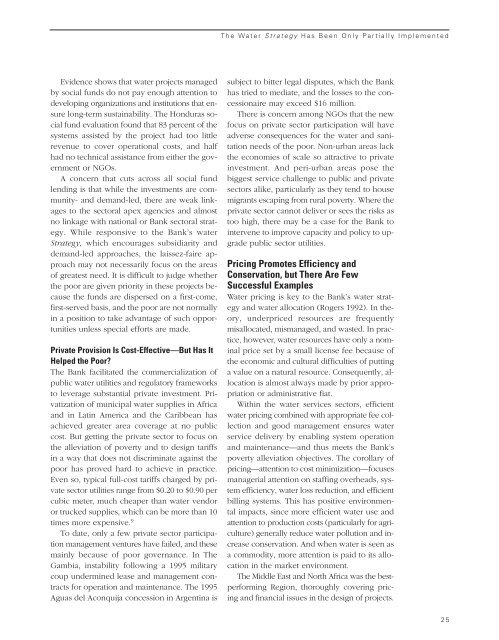Download Report - Independent Evaluation Group - World Bank
Download Report - Independent Evaluation Group - World Bank
Download Report - Independent Evaluation Group - World Bank
Create successful ePaper yourself
Turn your PDF publications into a flip-book with our unique Google optimized e-Paper software.
The Water Strategy Has Been Only Partially ImplementedEvidence shows that water projects managedby social funds do not pay enough attention todeveloping organizations and institutions that ensurelong-term sustainability. The Honduras socialfund evaluation found that 83 percent of thesystems assisted by the project had too littlerevenue to cover operational costs, and halfhad no technical assistance from either the governmentor NGOs.A concern that cuts across all social fundlending is that while the investments are community-and demand-led, there are weak linkagesto the sectoral apex agencies and almostno linkage with national or <strong>Bank</strong> sectoral strategy.While responsive to the <strong>Bank</strong>’s waterStrategy, which encourages subsidiarity anddemand-led approaches, the laissez-faire approachmay not necessarily focus on the areasof greatest need. It is difficult to judge whetherthe poor are given priority in these projects becausethe funds are dispersed on a first-come,first-served basis, and the poor are not normallyin a position to take advantage of such opportunitiesunless special efforts are made.Private Provision Is Cost-Effective—But Has ItHelped the Poor?The <strong>Bank</strong> facilitated the commercialization ofpublic water utilities and regulatory frameworksto leverage substantial private investment. Privatizationof municipal water supplies in Africaand in Latin America and the Caribbean hasachieved greater area coverage at no publiccost. But getting the private sector to focus onthe alleviation of poverty and to design tariffsin a way that does not discriminate against thepoor has proved hard to achieve in practice.Even so, typical full-cost tariffs charged by privatesector utilities range from $0.20 to $0.90 percubic meter, much cheaper than water vendoror trucked supplies, which can be more than 10times more expensive. 9To date, only a few private sector participationmanagement ventures have failed, and thesemainly because of poor governance. In TheGambia, instability following a 1995 militarycoup undermined lease and management contractsfor operation and maintenance. The 1995Aguas del Aconquija concession in Argentina issubject to bitter legal disputes, which the <strong>Bank</strong>has tried to mediate, and the losses to the concessionairemay exceed $16 million.There is concern among NGOs that the newfocus on private sector participation will haveadverse consequences for the water and sanitationneeds of the poor. Non-urban areas lackthe economies of scale so attractive to privateinvestment. And peri-urban areas pose thebiggest service challenge to public and privatesectors alike, particularly as they tend to housemigrants escaping from rural poverty. Where theprivate sector cannot deliver or sees the risks astoo high, there may be a case for the <strong>Bank</strong> tointervene to improve capacity and policy to upgradepublic sector utilities.Pricing Promotes Efficiency andConservation, but There Are FewSuccessful ExamplesWater pricing is key to the <strong>Bank</strong>’s water strategyand water allocation (Rogers 1992). In theory,underpriced resources are frequentlymisallocated, mismanaged, and wasted. In practice,however, water resources have only a nominalprice set by a small license fee because ofthe economic and cultural difficulties of puttinga value on a natural resource. Consequently, allocationis almost always made by prior appropriationor administrative fiat.Within the water services sectors, efficientwater pricing combined with appropriate fee collectionand good management ensures waterservice delivery by enabling system operationand maintenance—and thus meets the <strong>Bank</strong>’spoverty alleviation objectives. The corollary ofpricing—attention to cost minimization—focusesmanagerial attention on staffing overheads, systemefficiency, water loss reduction, and efficientbilling systems. This has positive environmentalimpacts, since more efficient water use andattention to production costs (particularly for agriculture)generally reduce water pollution and increaseconservation. And when water is seen asa commodity, more attention is paid to its allocationin the market environment.The Middle East and North Africa was the bestperformingRegion, thoroughly covering pricingand financial issues in the design of projects.25
















